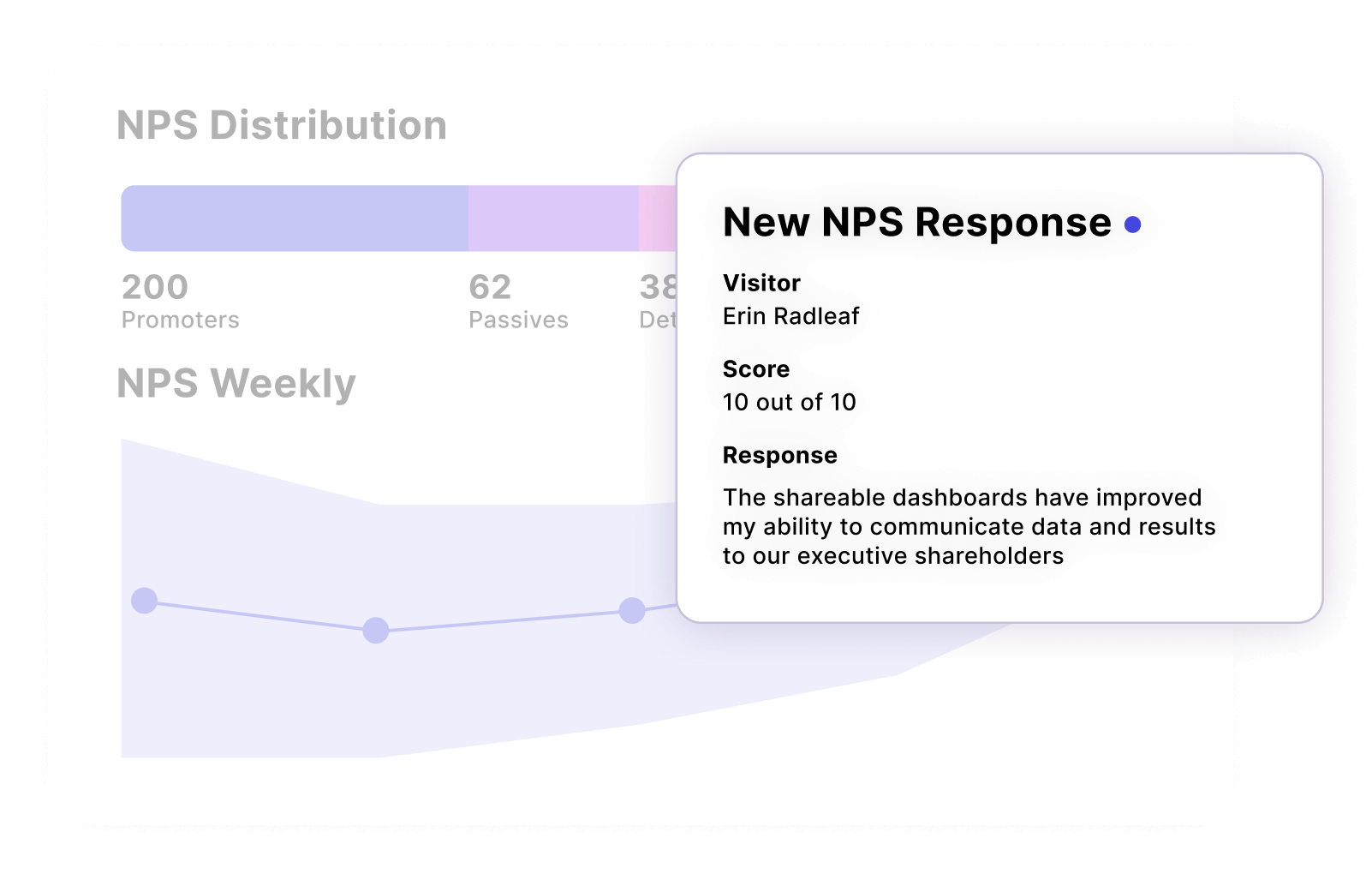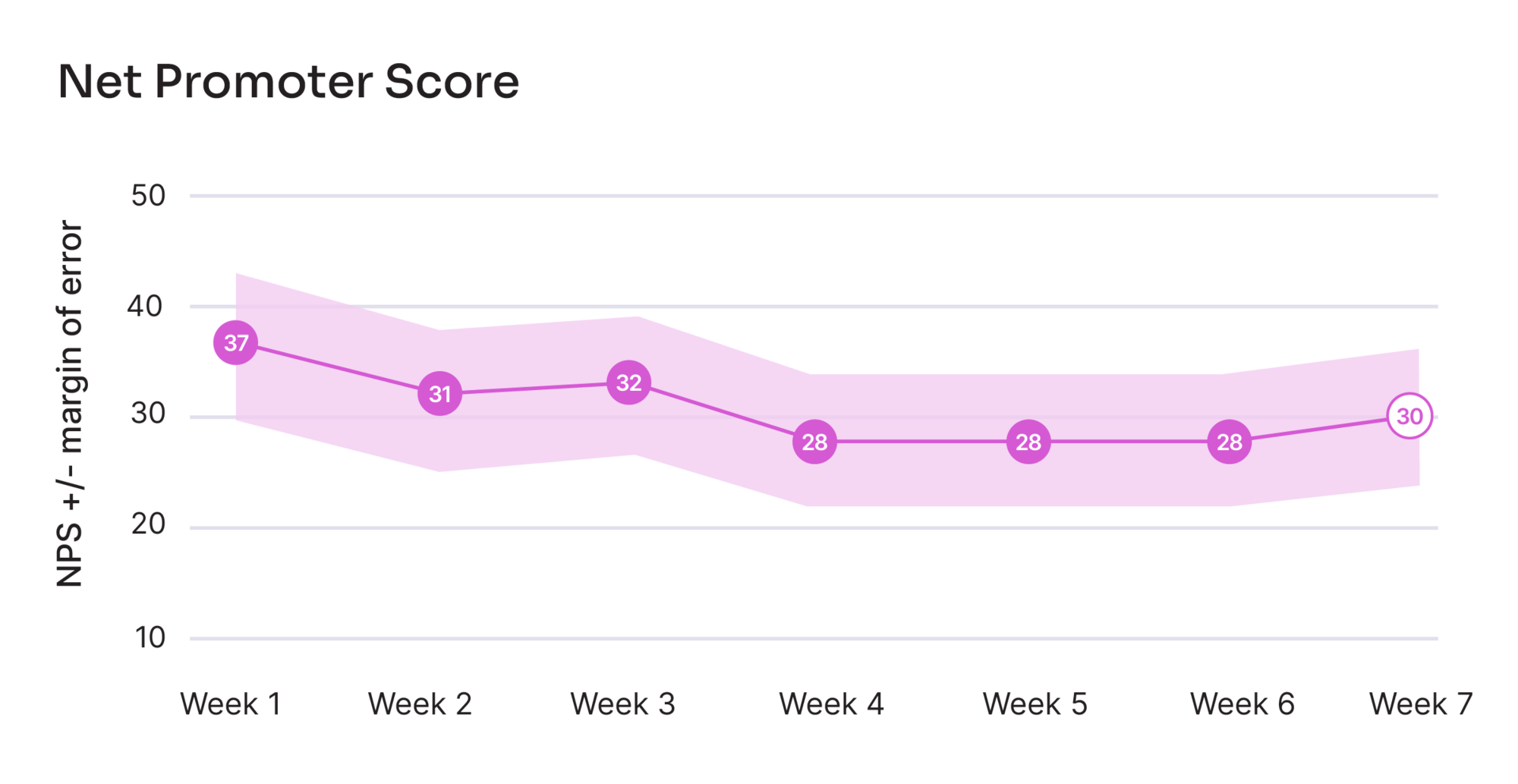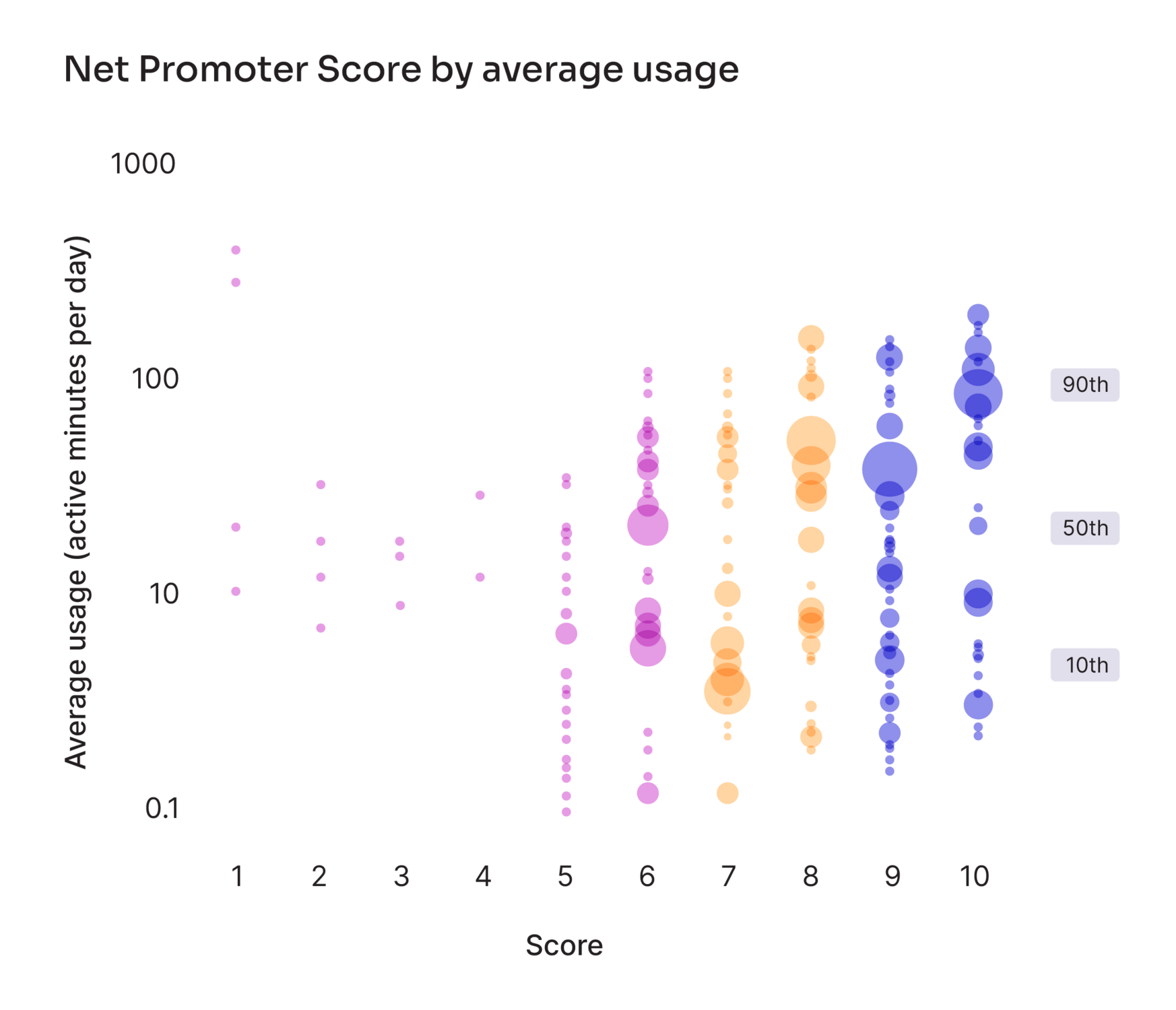
包括的ガイド
ネットプロモータースコア(NPS)
顧客のブランドに対する支持を示す指標。顧客満足度、ひいてはビジネスの成長度も示す。
さらに深く掘り下げる
目次
ネットプロモータースコアとは何ですか?
ネットプロモータースコア(NPS)は、企業が顧客のブランドに対する支持を測定するために使用する指標で、顧客満足度、ひいてはビジネスの成長度も示します。
Because NPS reduces such a large question to a single-question (“How likely is it that you’d recommend this brand to a friend or colleague?”) survey with an answer limited to an 11-point (0-10) scale, many business leaders debate its merits. Despite grievances around oversimplification, NPS has emerged as one of the most pervasive KPIs for customer satisfaction in business today.
ネットプロモータースコアの計算方法は?
計算方式は簡単です。企業でお客様を対象にNPS調査を実施するとします。スコア9~10を「推奨者」、7~8を「中立者」、0~6を「批判者」として分類します。その後、推奨者の割合から批判者の割合を引いて算出された数値が、ネットプロモータースコアになります。
ネットプロモータースコアの計算式は次のとおりです。
推奨者より批判者が多い企業では、NPSはすぐにマイナス領域に落ち込んでしまうでしょう。もちろん、理想的ではありませんが、NPSがマイナスになることは珍しくありません。NPSスコアは業種によって大きく異なるため、企業はデータを利用できる最も類似したコホートに対してベンチマークを行うことが重要です。また、企業が自社に対してベンチマークを行い、NPSの動きを経時的に追跡することも重要です。スコアの変化をプロダクトの変更やマーケティングキャンペーンなどのビジネスイベントにマッピングすると、企業がどのような開発が顧客満足度に影響を与えるかを理解するのに役立ちます。
NPS計算の経時的追跡
優れたネットプロモータースコアとは
優れたネットプロモータースコア(NPS)は業界によって異なりますが、一般的に、0を超えるスコアは肯定的で、批判者よりも推奨者が多いことを示しています。50を超えるスコアは優れたNPSで、顧客ロイヤルティが高いことを示します。さらに70を超えるスコアは稀で、一際優れていることを示します。
NPSが重要な理由
ネット・プロモーター・スコア(以下、NPS)は、現在の顧客センチメントの概要を提供するだけではなく、将来のビジネスの可能性を示す強力な指標でもあります。顧客が貴社のブランドを積極的に支持してくれる場合、それは顧客の満足度とロイヤルティを反映するものです。そして、それが長期的な成長に直接影響します。短期的なNPSの向上に重点を置くのは自然なことですが、一貫して高いNPSというのは単なる数字ではなく、自社ブランドが持続的な成功をもたらす忠実な顧客基盤を構築しているかどうかを示すシグナルであることを認識することが重要です。スコアの改善に取り組む際には、NPSの真の価値は、長期的なビジネスの成長を予測し、促進する能力にあることを念頭に置きましょう。
トランザクションNPSプログラムとリレーショナルNPSプログラムの違い
Transactional NPS: Measures satisfaction after specific interactions, like purchases or support calls, offering immediate feedback on those experiences.
Relational NPS: Assesses overall customer loyalty periodically, providing insights into the long-term relationship and overall brand perception.
NPSデータの活用方法
NPSデータを活用して顧客フィードバックを分析し、顧客を推奨者、中立者、批判者にセグメント化し、これらのインサイトをCRMに統合します。これにより、傾向を特定し、解約を減らし、顧客体験を向上させ、マーケティング活動をカスタマイズできるようになります。
For example: Use your product analytics tool like Pendo Analytics to plot account-level NPS against product usage and account size to determine which customers may be at the highest risk of churn.
NPS調査のベストプラクティス
アンケートは簡潔にする:アンケート疲れを避けるために、アンケートは必要な質問に絞りましょう。
タイミングを最適化する:インタラクションの直後にアンケートを送信するか、リレーショナルNPSの場合は定期的に送信しましょう。
フィードバックに基づいて行動する:批判者をフォローアップして問題に対処し、推奨者のサポートに感謝しましょう。
従業員ネットプロモータースコア(eNPS)とは
従業員ネットプロモータースコア(eNPS)は、従業員が自分の職場を友人に勧める可能性を尋ねることで、従業員の忠誠心を測定するものです。これは、従業員の満足度を測定し、より良い職場環境を育むために改善が必要な領域を明らかにするのに役立ちます。
企業のネットプロモータースコア(NPS)に影響を与える要因は何ですか?
特にソフトウェア企業にとって、アカウントレベルのNPSとユーザーレベルのNPSの違いを理解することは重要です。ユーザーNPSは、ソフトウェアを定期的に使用している人のスコアを収集したものです。その人はプロダクトに最も近いところにいるため、そのスコアはアカウントスコアよりも高い可能性があります。後者は、プロダクトからより遠いところにいて、あまり情報を持たない人の視点であるため、スコアが低くなる可能性があります。
NPSの追跡は、すぐに洗練されたものになります。スコアが取得される媒体も、結果にバイアスをかける可能性があります。プロダクト自体の中で実施されたNPS調査は、メールによる調査よりも高いスコアになる可能性があります。これは、前者の方がアクティブで熱心なユーザーが集中しているためです。
上記の点は、ユーザーNPSやアプリ内NPSを他と比べたときの価値の違いを示すことを意図したものではありません。バイアスを認識し、時間の経過とともにベンチマークを行うときに一貫性を保つことが役立つということだけです。
The method of collecting survey data isn’t the only factor that impacts an NPS score. The buying experience, onboarding process, and, of course, the product itself all have the potential to create Detractors and Promoters alike. To this end, understanding which pages or features in the product increase customer satisfaction and guiding users to those features is one of the most reliable ways to improve NPS over time. For example, Cision Trendkite found that depth of use had a significant impact on customer satisfaction–their Promoters used a much larger set of features in the application compared to Detractors and Passives.
How to design effective NPS surveys
Designing an NPS survey is about more than asking one question. The way you word the question, when you deliver it, and how you follow up determines whether the Net Promoter Score (NPS) is meaningful or misleading. Strong survey design increases accuracy and makes results actionable.
Sample NPS survey questions (good vs. bad)
Strong NPS survey design starts with neutral, clear wording. Leading questions bias results and reduce reliability.
Strong Wording
- “On a scale from 0–10, how likely are you to recommend [Product] to a colleague or friend?”
- “Would you recommend us because we provide the best service?”
Weak Wording
- “How likely are you to recommend [Product] to others?”
- “How satisfied are you with our great software?”
Best practices for NPS survey questions:
Keep the core question short and neutral.
Pair the score with an open-text follow-up (“What is the main reason for your score?”).
Run surveys at relevant moments: after onboarding, following major updates, or on a quarterly cycle.
Pendo enables teams to launch in-app NPS surveys that appear in the context of the product experience. This improves response rates and ensures feedback reflects the user’s actual journey.
NPSの測定方法
Choosing the right NPS software is critical for turning customer feedback into actionable insights. While many NPS tools collect survey responses, what differentiates the most effective tools comes down to connecting responses to product usage and customer outcomes.
Most NPS tools deliver surveys by email or SMS and provide dashboards for basic reporting. These approaches work for surface-level insights but often miss the context of when and where customers interact with your product.
Why Pendo stands out
Pendo approaches NPS differently by embedding surveys directly inside the product experience. This in-app delivery increases response rates and ensures feedback reflects the user’s actual journey.
Pendo’s NPS software also allows teams to:
- Segment responses by product usage, customer cohort, or account attributes.
- Combine NPS feedback with product analytics to identify what features promoters and detractors use most.
- Track changes over time to see how product improvements affect loyalty.
- Share insights across product, success, and leadership teams to drive coordinated action.
Because Pendo integrates NPS results with behavioral data, teams can answer deeper questions: Which features improve sentiment? Where do detractors struggle? How do promoters differ from passives in adoption? This transforms NPS from a survey into a customer loyalty metric tied directly to product strategy and growth.
Implementation checklist for NPS success
Implementing NPS requires a structured approach. A clear process ensures reliable results and actionable insights.
Before the survey
Define your goal: retention improvement, churn prevention, or referral tracking.
Choose the type of survey: relationship NPS (ongoing loyalty) or transactional NPS (event-based).
Select your channel: in-app (via Pendo) or external (email, SMS).
During the survey
- Write a neutral NPS question.
- Include an open-text follow-up to capture reasons.
Target the right audience: new customers, active users, or long-term accounts.
After collecting results
- Segment into Promoters, Passives, and Detractors.
- Share findings across product, customer success, and leadership.
Act quickly: thank promoters, address detractors, and analyze themes.
Pendo automates this process. In-app surveys deliver higher participation. Analytics dashboards reveal why scores shift. Segmentation ensures actions are targeted and measurable.
NPS and business outcomes
Net Promoter Score is more than a survey result. When managed correctly, it is a leading indicator of growth, retention, and product adoption. Unlike lagging financial metrics, NPS reveals customer sentiment early, giving teams the chance to act before outcomes show up in revenue.
Retention and churn
- Detractors (scores 0–6) often signal early churn risk.
- Identifying them quickly allows customer success teams to intervene.
- Promoters (scores 9–10) renew more frequently and are less price-sensitive.
Expansion and referrals
- Promoters are more likely to expand their product use and adopt new features.
- They also generate organic growth through referrals and word-of-mouth advocacy.
- In SaaS, this directly lowers customer acquisition costs and boosts account expansion.
Benchmarks and industry growth
Research from Bain & Company shows that loyalty leaders—companies with the highest NPS in their industries—grow at more than twice the rate of their competitors. This positions NPS not just as a measure of customer experience, but as a proxy for long-term business health.
Pendo を選ぶ理由
Pendo connects NPS responses with product analytics, so organizations see why promoters or detractors feel the way they do. With in-app delivery, segmentation by behavior, and trend tracking over time, Pendo enables teams to:
- Correlate NPS with feature adoption and product usage.
- Prioritize roadmap decisions based on customer sentiment.
- Demonstrate how improving NPS links directly to churn reduction and revenue growth.
This integrated view transforms NPS from a score into a strategy for sustainable growth.
ネットプロモータースコアについてもっと詳しく知りたいです。
For those looking to dig a little deeper, there are a number of books on the subject, beginning with the one that started it all: Fred Reichheld’s “The Ultimate Question” (which is now available as a 2.0 edition) as well as free resources on how to improve NPS score. There are premium NPS analytics and insights solutions and free NPS survey tools available and any number of websites that publish NPS benchmarks by industry.





